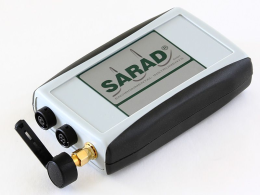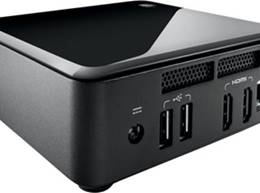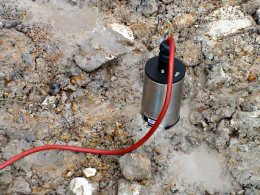

The internal measurement chamber of the standard version has been replaced by the separate soil gas probe. The probe contains the Radon measurement chamber as well as the sensors for temperature and humidity and the shock detector. The compact and rough cover made from stainless steel and Acetal allows the usage of the probe inside bore holes from 80 mm up. All electronics and the detector are protected by a special Urethane coating to ensure a long operation time even under extreme conditions as expected in seismic and volcanic active areas (e.g. H2S). A large area Silicon rubber diffusion membrane results in short response time. We guarantee a water tightness up to one meter immersion depth.
The control panel of the instrument and the rechargeable battery 12 V/12 Ah are installed inside a solid and sealed (IP66) Aluminium enclosure. Optionally, a radio modem and a clock timer to switch on/off the modem periodically are available.
The battery enables an autonomous operation of more than 60 days. An external power supply, either a mains power adapter or a solar panel can be connected to recharge the battery permanently. The internal battery can be replaced by an external one with higher capacity without much effort.
The soil gas probe is connected by an up to 10 m long cable. All connections (soil gas probe, external power, external battery) and the cable feed-through are placed on the bottom panel of the unit.
Accessories

With Net Monitors it is possible to implement a wireless local network for SARAD instruments, or simple to read out the data without a cable connection. The range of the radio link is several hundred meters in case of a free line of sight. For stationary linking, the range can be extended by directional antennas. A PC adapter, called “coordinator” and at least one instrument adapter (endpoint) are required to create the network. The coordinator is connected to the PC by a USB cable. The instrument adapter can be connected to the serial interface (RS232) of the instruments. The link cable is included in the delivery. To power the instrument adapter, either the internal replaceable batteries or an AC/DC wall adapter can be used. The batteries enable an autonomous operation of several weeks. Many instruments are already equipped with an internal instrument adapter.
As soon as an instrument enters the link range of a coordinator, it will be automatically linked into the network. All SARAD software products contain already the network functionality. The communication takes place in the same way like through a cable connection. The only difference is that before any action which requires the communication with the instrument, a selection table with all linked instrument appears on the screen.
The network uses a similar standard like the WLAN with a maximum link power of 100 mW. The endpoint does not send any information as long it is not in the link range of a coordinator.

The software solutions Radon Vision (from version 6.2.0) and dVISION/dCONFIG (from version 3.3.1) contain a complete solution for TCP/IP based communication with the most of SARAD instruments. The Implementation is very easy and does not require special skills in the IT field.
The IP-Box, in fact, is a robust, tiny (15mm x 111mm x 51mm), pre-configured computer with SSD and Windows operational system. The program Instrument Server is already installed in the auto-start folder of Windows (see also application note AN-008: Internet based monitoring networks for SARAD instruments). It will be opened automatically after turning on the power. The IP-Box is equipped with several USB and serial ports to connect the instruments. The connection to the internet can be realized either by LAN cable or WiFi. The WiFi adapter is integrated in the IP-Box.

